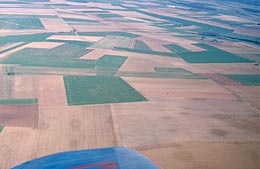- Home
- Discoveries
- The first farmers
- The construction of camps and the beginning of flint mining
Neolithic flint extraction pits at Hallencourt (Somme).
Partially destroyed Neolithic enclosure at Missy-sur-Aisne (Aisne).
Although the first farmers seemed to have lived in an egalitarian society, this was no longer the case by around 4,500 BCE, when social differentiation began to emerge little by little in the Cerny and Post-Rössen cultures, and later the Michelsberg and Southern Chasséen cultures.
Enclosures and camps with palisades and interrupted ditches became increasingly common. We can distinguish between valley enclosures surrounding villages, like at Berry-au-Bac (Aisne), and raised camps, such as at l'Étoile (Somme). These moated enclosures required enormous amounts of labor to construct. Their function is still not clearly understood. Nevertheless, several hypotheses have been advanced: a place where the community would be safe from animals, a fortified area offering protection from other human groups, a main habitat common to several villages, a market or place of assembly — and even a sanctuary for special occasions. Clearing the land would have required a large number of flint tools.
Major flint extraction sites and workshops have been discovered. Néolithic humans dug pits in the chalk to reach layers of good quality flint, and set up workshops in the vicinity. The entrance to these pits, which appear here as white dots ringed with a large, dark patch, are not very visible from the air (Hallencourt, Somme).


